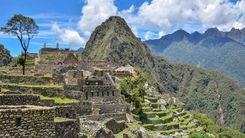Brief history
From humble beginnings, Caral developed into one of the earliest metropolises, representing human achievements that took place four thousand years earlier than the Incas: the stone ceremonial structures here were flourishing a hundred years before the Great Pyramid at Giza was even built.
Archeologists have studied its temples, houses and plazas, and the artefacts unearthed here, to form a picture of the ancient Caral culture, which focused heavily on agriculture and construction. There’s evidence of ceremonial functions, too, and music was also important: a collection of coronets and flutes have been found on site.
The site
The heart of the site covers about 150 acres. There are two large, sunken circular plazas, the base of the tallest mound measurimg 154m by 138m, making it the largest pyramid yet found in Peru. Excavations have revealed that this Piramide Mayor (main pyramid) was terraced, with a staircase leading up to an atrium-like platform, culminating in a flattened top housing enclosed rooms and a ceremonial fire pit. Some of the best artefacts discovered here include 32 flutes made from pelican and animal bones and engraved with the figures of birds and even monkeys, demonstrating a connection with the Amazon region.
The six mounds, or pyramids, are arranged together around a large plaza. Archeologists believe that the pyramids were constructed in a maximum of two phases, which suggests a need for particularly complex social structures for planning, decision-making and the mobilization of a large sector of the population to provide sufficient labour as and when it was required. Around the pyramids is evidence of many residential structures.



